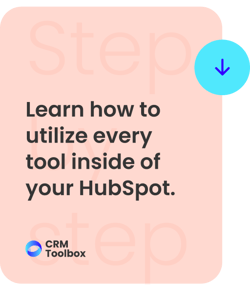Subscribe to ur Blog

If you already work with one of the HubSpot Hubs and are starting to consider expanding your product portfolio to complement your operation and fully optimize the benefits of HubSpot in each area of your company, you might be asking if you should approach this expansion gradually or all at once.
This is even more noticeable for users who are just about to migrate to HubSpot and want to include everything immediately since they are convinced of the advantages this platform can bring to their business.
Therefore, when a client asks us if they should do it all at the same time or one at a time, our first answer is that it will depend a lot on their requirements, time, and resources. The reality is that it can be done in either of the two ways, however, each one has its advantages and disadvantages. Rather than telling you which one is right for you, I'm giving you the pros and cons so you can make a more informed decision.
The Basics
Regardless of which path you choose, there are certain things you will need to do before you start scheduling your first automation, sending an email, or designing a workflow. Here are the steps you need to take to ensure the rest of the journey works as intended:
Data Structure
This is one of the most important points when implementing HubSpot into your company, no matter which of the Hubs you choose or what your process will be. When the data is not well structured from the beginning, the risk of errors increases considerably. Data is your company's most valuable resource (and the fuel that drives HubSpot), so if the fields you will use aren't well defined or mapped correctly, everything built on top of it will fail. Poor data structure makes your setup as fragile as a house made of cards. When you start to connect systems and accumulate data from users who interact with your brand, one of the main bottlenecks can be how this data is processed, what data is valuable to your operation, and how you are capturing it. Not being clear on these aspects generates unnecessary noise in the primary system (CRM) and can hinder the operation as well as worsen the final customer experience.
From duplicate customers to data being captured poorly or assigned to the wrong objects, a lack of data structure is definitely one of the biggest problems we run into.
A good data structure considers all aspects of the business, from alignment between areas (more on that later) to better reporting and analysis of information.
Data Cleaning
The structure is key and cleaning is the first process that derives from it. Once the criteria for assigning data to the different objects within the platform is well defined, the next thing to do is to clean the data to delete duplicates and eliminate incorrect information. This helps the Hubs work with information that is really necessary, preventing automation failures and creating more reliable reports and better long-term results.
Mapping the Processes
Before any automation, it is important to have a map of what the sales, lead qualification, and post-sale service processes are like in your company. Having a clear map of what the flows currently look like makes it simpler when you want to translate them to HubSpot.
When the mapping is not done before approaching the platform, the result worsens. Your task becomes about building new flows on a less solid foundation, which translates into automatons that do not work entirely well, processes that break, and dissatisfied customers.
Ultimately, mapping is the architectural blueprint that developers will use to build on HubSpot.
Align All The Areas
Yes, HubSpot results in a more natural alignment between the different areas of your company, be it service, sales, or marketing. However, not everything can fall on the platform. If there is no support from the management of the company and a true commitment of the areas to work together and not individually, having data that flows freely between departments of the company will not be enough.
Smarketing (the alignment between marketing and sales) is only achieved with the indicated platform (in this case HubSpot) and the support of the company's main stakeholders. Therefore, if the implementation is not accompanied by a true desire to change the way of working, you will not be able to see any benefits.
In this alignment stage, the criteria that will be taken for the rotation between marketing prospects (MQL) and sales prospects (SQL) should be considered. There should be clear expectations about SLA that each of the areas must meet and it is crucial to maintain an objective approach and avoid blaming others when results are not given.
Train, Train, Train
Regardless of the order in which you want to implement your Hubs, including training for everyone involved is beneficial. It will be of little use to implement your Hubs with time or all at once if there is resistance to change due to your collaborators' potential lack of knowledge on how to use the platform. It is important that everyone feels included in the change and sees it as an opportunity to streamline processes and not as a switch that will only generate more work.
How To Implement?
One Hub at a Time:
This means that you must choose which area is most in need of change and start there. It is important that you are clear about the time that each implementation will take so that the step-by-step schedule is transparent to everyone in the company until all the Hubs are active.
These are some of the advantages:
- Less Initial Investment: An implementation can be a significant investment for the company since there is an investment in the platform and the cost of hiring a specialized agency to help you with onboarding. By doing it in parts, you can better disperse these payments, giving the company greater financial flexibility and avoiding having all the expenses reflected in the same billing period. The downside of doing it this way is that you can only see the full return on your investment when you finish the whole process.
- Greater Control: By doing the integration in parts, you have greater visibility and control of what is happening since the focus is on a specific area and there will be more eyes on that part of the company to guarantee that the first Hub is working perfectly before you jump to the next one. However, it is a much slower process that can become tedious since your collaborators will feel this stage of change for a long time. By the second or third implementation, it may start to feel repetitive and monotonous.
- Fewer Locked Resources: Any migration has an in-process impact on the operation. So having sales, marketing, and service teams simultaneously engaged in the migration can significantly decimate the customer experience. By doing it in phases there will always be areas of the company that maintain the status quo and whose operation is not diminished.
- Anticipated ROI: Justifying any investment in technology must come with an expected return. If you do it in parts, you can start with the Hub that gives the greatest short-term return such as the Marketing Hub. You can leave the Service Hub for last, because it also generates added value and increases the customer's lifetime, but is the one that will take the longest to give a positive return
Three All At Once:
You will have to allocate more resources (financial and human) to the project, but it is definitely possible. It may be a little more painful, but it will be like ripping off a bandage: more painful at first with a shorter pain. The advantages of implementing all three Hubs at once are:
- Faster: If the name of the game is speed, then a bulk implementation/migration is the best solution. Yes, these will be very complex months for the operation of your company, but the light at the end of the tunnel will be seen ahead of time and this can be inspiring for your collaborators.
- More Complete Results: Instead of dividing the success of the project by areas, a massive implementation makes it possible to see the results and the general return on your investment much sooner. Furthermore, the customer experience will be significantly improved from the beginning instead of in parts. It is a more comprehensive approach to technological enhancement within your company.
As you can see, the decision must be accompanied by an analysis of the current situation of your company, including your immediate pains and how limited you are in terms of human and financial resources. If you're still not entirely sure which path is the best for your company, one way to find out is by talking to someone who has done these types of migrations in the past. At CRM Toolbox, we have helped all kinds of companies with their implementations and integrations to HubSpot and we know how overwhelming it can seem. Feel free to schedule a call with me and explain what your current situation. Together we can find the best way for you to start seeing the benefits of HubSpot as soon as possible.
Related Reads
Master HubSpot tools & unleash a world of endless possibilities!
Unlock Your HubSpot Powerhouse: Contact Us to Transform Your Digital Journey!

Ranya Barakat
Ranya is a serial entrepreneur with over 11 years of experience working on the HubSpot CRM. She is a tech geek with a passion for solving problems for customers. She loves pushing her sleeves up , and getting s*** done. When she is not running her Global services team, you can find her upside down on her yoga mat.
Subscribe to our blog
The best information about inbound marketing, sales, guides and migrations.



